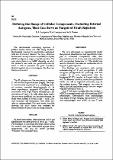Defining the Range of Cellular Components, Including Internal Antigens, That Can Serve as Targets of Graft Rejection

View/
Author
Lampson, M. A.
Dunne, A. D.
Note: Order does not necessarily reflect citation order of authors.
Published Version
https://doi.org/10.1155/NP.1992.240Metadata
Show full item recordCitation
Lampson, L. A., M. A. Lampson, and A. D. Dunne. 1992. Defining the Range of Cellular Components, Including Internal Antigens, That Can Serve as Targets of Graft Rejection. Journal of Neural Transplantation & Plasticity 3(4): 240-241.Abstract
The mechanisms underlying rejection of grafted neural tissue are still being defined. Mechanisms relevant to genetically engineered cells are of current interest. To date, attention has focused on major histocompatibility complex (MHC) antigens as targets of graft rejection. Yet even when there is no MHC disparity, as when the patient's own cells are genetically altered, there is still a potential for graft rejection, directed against the novel antigens. We illustrate this in a rat model.Other Sources
http://www.ncbi.nlm.nih.gov/pmc/articles/PMC2565169/pdf/Terms of Use
This article is made available under the terms and conditions applicable to Other Posted Material, as set forth at http://nrs.harvard.edu/urn-3:HUL.InstRepos:dash.current.terms-of-use#LAACitable link to this page
http://nrs.harvard.edu/urn-3:HUL.InstRepos:8462355
Collections
- HMS Scholarly Articles [17922]
Contact administrator regarding this item (to report mistakes or request changes)


